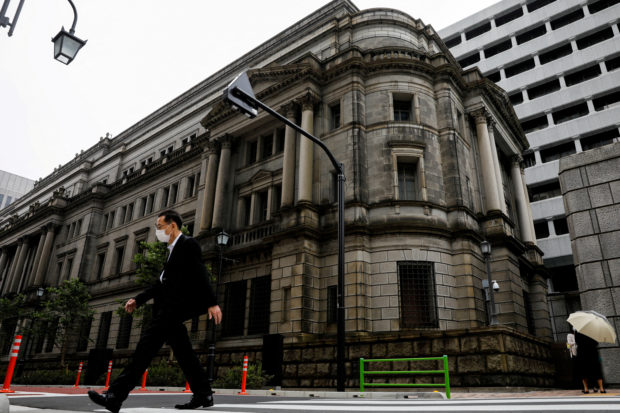
A man wearing a protective mask walks past the headquarters of Bank of Japan in Tokyo. REUTERS/Kim Kyung-Hoon/File Photo
TOKYO – Something has gone missing from Bank of Japan statements about elevated inflation: the word “temporary”.
No longer signaling that robust price rises will be short-lived, the central bank might soon go further by saying they will become faster than expected for the rest of this year, driven in part by the yen’s slide to 24-year lows, said three sources familiar with its thinking.
The Bank of Japan (BOJ) still expected inflation to slow next year, but maybe not as much as previously thought, they said.
The implication is that the country’s ultra-easy monetary policy, holding both short- and long-term interest rates near zero, may not last as long as forecasters believe, though the sources said that, with the economy weak, the stimulus would not be withdrawn soon.
Most of 36 economists surveyed by the think tank Japan Center for Economic Research this month expected monetary policy to remain unchanged until the end of next year.
But one of the sources, describing BOJ internal debates, said: “Companies are passing on rising costs to households at a faster-than-expected pace. Inflation may not slow much next year if consumption holds up.”
Consumers’ inflation expectations are also heightening, and price rises in the deflation-prone country have clearly spread to items not directly affected by rising fuel costs.
Until June, BOJ officials, making speeches and internally discussing policy, frequently described underlying rises in inflation as “temporary”. But they stopped doing so in July, according to transcripts and minutes of the policy meetings.
While the speeches were public, few people, if any, noticed the tweak.
“It was probably not the best language to describe what was happening in the global and domestic inflation landscape,” a second source said on the word “temporary.”
Other central banks, notably the U.S. Federal Reserve, European Central Bank and the Bank of England, last year similarly said rising inflation would be only temporary. Caught off guard, now they have raised interest rates much further than they expected.

A fish vendor at the Ameyoko shopping district in Tokyo, Japan. REUTERS/Kim Kyung-Hoon/File Photo
Price pressure
Among the latest evidence in Japan of rising price pressures, annual core consumer inflation, which excludes fresh food but includes fuel costs, hit a seven-and-a-half year high of 2.4 percent in July, exceeding the BOJ’s 2 percent target for a fourth straight month.
The BOJ currently forecasts the rate will fall below 2 percent next year.
Nearly 80 percent of Japan’s listed food companies have either raised prices this year or plan to do so, four times the ratio of last year, according to a survey by private research firm Teikoku Databank.
These rises affect more than 20,000 food items, which will go up by an average of 14 percent. One-third of the increase is scheduled to take effect in October, a sign that inflationary pressure could intensify later this year.
Most BOJ policymakers now expect core consumer inflation to reach 3 percent in October, with some projecting the upward pressure to persist well into next year, the sources said.
A consumer price index that excludes both fresh food and fuel costs – closely watched by the BOJ as a key barometer of domestic demand – was 1.2 percent higher in July than a year earlier, marking the fourth straight month of annual gains.
Some BOJ officials saw a chance of inflation as measured by that index reaching 2 percent in coming months, the sources said.
They predicted that the stronger price outlook would lead to an upward revision to the BOJ’s inflation forecasts when the board next revises its quarterly projections in October.
The key would be whether wages would start to rise in response to the increasing cost of living. Only when wages rose faster would Japan experience a demand-driven, sustained increase in inflation that the BOJ is seeking to achieve.
Currency moves
The role of the weakening yen, which is down nearly 20 percent so far this year, is becoming a focus for the BOJ.
“Currency moves are among key factors that affect the economy and prices. For the BOJ, the impact on prices warrants particular attention,” a third source said, signaling that rising inflationary pressure from the weak yen would be a key topic in the bank’s public communications in coming months.
There are early signs Japan is finally losing its sticky deflationary mindset. In August, more than 90 percent of households expected prices to increase over the following 12 months, a government survey showed, with nearly 60 percent projecting a rise of 5 percent or more.
But there is also uncertainty about Japan’s growth outlook as the U.S., European and Chinese economies face headwinds.
“Cost-push pressure is heightening at a degree never seen before, prodding firms to raise prices. Some profitable firms are raising wages, too,” said former BOJ board member Goushi Kataoka.
“The problem is that the global economy may enter a slump before this positive cycle gains momentum.”
RELATED STORIES:
Japan’s Aug wholesale inflation hits 9% as price rises broaden Japan’s household spending extends growth but inflation risks loom

